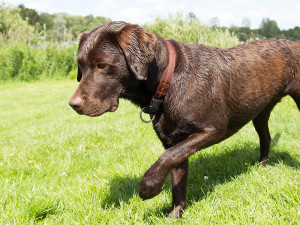1 in 10 Dogs Will Get Kidney Disease. Here’s What to Do
It can’t be cured, but it can be managed. Partnering with your vet will be the key.

Share Article
Maybe you made a veterinarian appointment because your dog spends more time at the water bowl, seems overly thin, and shies away from food they used to love. When your vet diagnoses your dog with chronic kidney failure — also known as chronic renal disease (CRD) or chronic kidney disease — how can your heart not sink? But as scary as it might sound, CRD can be managed, and there are more joyful days with your pup ahead. Here’s everything you need to know about kidney failure in dogs, including the causes, signs, and treatments.
What Do The Kidneys Do?
The kidneys have many functions. The two bean-shaped organs are responsible for water conservation, blood pressure control, salt balance, phosphorus and calcium regulation, and the initial step in red blood cell production. When the kidney’s performance of these jobs begins to falter, many of the body’s functions start to tumble, too. The result? Blood levels of BUN (blood urea nitrogen), creatinine, calcium and phosphate escalate; there’s an increase of protein in the urine; potassium levels fall; red blood cell counts drop; and blood pressure rises. All those changes will cause your dog to start feeling very unwell.
What Is Chronic Kidney Disease in Dogs?
CRD is relatively common and affects one in ten dogs (compared to one in three cats). When you first see your vet, one of the initial medical goals will be to investigate and address the cause in an effort to stop the disease. There are many causes of kidney failure in dogs, including chronic bacterial infections, kidney stones, immune-mediated diseases, high blood pressure, congenital kidney malformations, leptospirosis, Lyme disease, grape/raisin or antifreeze poisoning, and cancer. Often, veterinarians don’t find the specific reason.
What are the symptoms?
Often, the first symptom of kidney failure a pet parent will notice is increased water consumption. Pets with kidney disease may also have urinary incontinence, vomiting, diarrhea, bad breath, blindness, depression or lethargy — all of which may be signs that the kidneys’ multitasking capacity is impaired. Another sign of kidney failure — elevations in BUN and creatinine levels — typically occurs when the kidneys have lost 75 percent of their function, which has made its treatment challenging. Idexx Laboratories does offer a blood test, SDMA (symmetric dimethylarginine), which catches kidney failure at the 40 percent mark and allows earlier intervention.

Kidney failure cannot be cured, but your veterinarian will address your dog’s symptoms — dehydration, nausea, weight loss, fatigue — with treatments fine-tuned by test results. If your dog’s getting nephrotoxic drugs like NSAIDs and certain antibiotics, they’ll take your dog off them, too.
How Is It Treated?
Treatment goals for kidney failure in dogs are life-long and supportive, aimed at improving quality of life and slowing disease progression. If your pup has CRD, you can approach the disease from an integrative approach, maintaining quality of life and slowing kidney degeneration.
Medication
Since the kidneys perform numerous functions, various medications are used to address specific disorders. ACE (angiotensin-converting-enzyme)–inhibitors are prescribed for hypertension and/or urine protein loss, antacids like famotidine or omeprazole for GI ulcers and overly acidic stomach, maropitant, and metoclopramide for nausea. When indicated, phosphate binders reduce nausea, and potassium supplements boost low levels.
Fluids
Your veterinary team can teach you how to give subcutaneous fluids at home, if needed, to hydrate your dog and flush out toxins. You can also encourage your pup to increase their water intake by providing a pet water fountain, adding wet food to their diet, and placing clean bowls with fresh water in multiple rooms.
Diet
Your vet will also likely suggest a diet change. Prescription diets, such as Royal Canin Renal MP and LP and Iams Renal Plus, restrict phosphorus and sodium, reduce protein, and add omega-3 fatty acids with B and C vitamins, a combination that has been tested to increase lifespan and overall quality of life. Restricting protein too early, but it can lead to muscle atrophy. IRIS, the International Renal Interest Society, endorses a kidney-specific diet when a dog’s creatinine level rises to 2.1 to 5 mg/dl (Stage III).To make it more likely that your dog will accept a new diet, make the switch slowly.
Supplements
The body does not store water-soluble B-complex and C vitamins, so we need to replace them every day. When dogs have CRD, these essential nutrients wash out too easily with the diluted excess urine. Prescription foods compensate for these expected losses, and Renal Essentials opens in new tab by Vetriscience, a highly palatable and balanced supplement with vitamins, potassium, fish oil and herbs, can be given twice daily as well.
Omega-3s
Studies show that high daily doses of oral omega-3 fatty acids enhance the function of the joints, heart, skin, brain, and kidneys. In one study, fish oils decreased mortality, improved renal function, and diminished protein loss. The recommended dose of marine fish oil, omega-3 EPA and DHA, is 300 mg per 10 pounds of dog weight. Do not use cod liver oil, as it may have excessive A and D vitamins.
Nutraceuticals
In the Manual of Natural Veterinary Medicineopens in new tab, Drs. Wynn and Marsden advocate traditional Chinese herbs for kidney failure in dogs, based on clinical experience. Studies in rats showed that Liu Wei Di Huang/Rehmannia 6 enhanced renal blood flow. Wynn and Marsden have also seen cats thrive for years when started in early-stage CRD on Shen Qi Wan/Rehmannia 8, another important formula. Rehmannia 8, with cinnamon and aconite, is warming, and this combination, when consistently used, can lower BUN and creatinine levels, reduce vomiting and thirst, boost appetite and weight, decrease urine volume, and increase urine concentration. Consult with a TCVM veterinarian for information on beginning and monitoring your pets on Chinese herbs.
Other holistic treatments
Rounding out a holistic kidney care plan, consider chiropractic to release spinal fixations and improve hind-end weakness that are common with kidney disease, and acupuncture to enhance the TCVM herbs’ effectiveness.

Sara Greenslit, DVM
Sara Greenslit, DVM, CVA, is a small-animal veterinarian and writer who lives and practices in Madison, Wisc.
Related articles
![Dog Drinking Water From A Pond In The Nature]()
Vets Issue A Warning After Two Dogs In Missouri Pass Away From Leptospirosis
The deadly disease is most common in autumn and late summer. Find out how to keep your pup safe.
![feeding black dog rice water to help relieve diarrhea]()
Vet-Approved Diarrhea Treatments
Shudder. It happens to all of us.
![Brown Labrador lifting front leg]()
How to Get a Head Start on Your Pet’s Health
Spot lumps, limps, and lethargy early on.
![A woman checking her dog for ticks outside in a grassy field.]()
Can Dogs Get Lyme Disease? Canine Lyme Disease Symptoms, Treatment, and Prognosis
It is peak tick season, so we asked a veterinarian for tips on how to prevent this dreaded disease.







